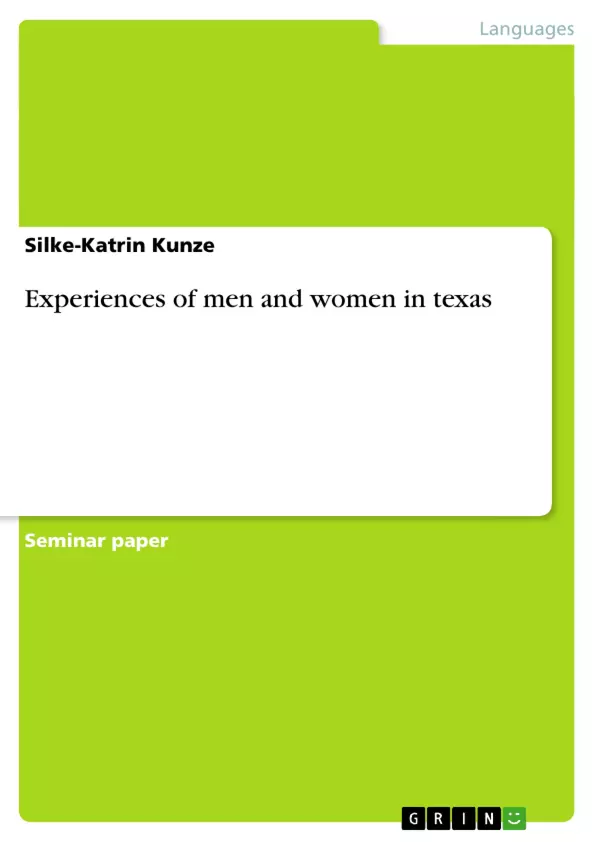This paper carries the title “Experiences of men and women in Texas” and is closely related to the subject of the Nineteenth Century American Frontier, the Voices of Frontier Women in specific. The westward expansion connected to the different frontiers in North America brought along new opportunities, of which making a fortune and leading a better life can be mentioned. According to Frederick Jackson Turner′s “The Significance of the Frontier in American History”, the frontier life many people sought furnished them with traits that dominate the American character today:
"That coarseness and strength combined with acuteness and inquisitiveness; that practical, inventive turn of mind, quick to find expedients; that masterful grasp of material things, lacking in the artistic but powerful to effect great ends; that restless, nervous energy; that dominant individualism, working for good and evil, and withal that buoyancy and exuberance which comes with freedom - these are traits of the frontier, or traits called out elsewhere because of the existence of the frontier."
In the seminar this paper refers to, several frontiers were mentioned and discussed. Among them the Hispanic and the Indian Frontiers as well as the Ranching and Cattle Frontier, all of which seem to play a role in Jo Ella Powell Exley′s Texas Tears and Texas Sunshine. This book forms the basis of the findings following this foreword.
In it, sixteen Frontier Women describe parts of their lives, whether it be conflicts with Indians and Yankee soldiers or struggles against natural forces. It covers a time frame from about 1821 until about 1905, thus, of course, including the year 1890 when the Bureau of the Census declared the frontier closed. This time frame is divided into four stages, which, as it becomes obvious from looking at the Table of Contents, was transferred here.
Inhaltsverzeichnis (Table of Contents)
- Foreword
- Overview
- Colonization, 1821 - 1835
- Introducing M.C.R., M.S.W.H. & A.R.T.C.
- Setting Out for Texas
- Indian Tribes
- Moving Frequently & Visiting Family and Friends
- The Republic, 1836 - 1846
- Introducing D.R.H., R.P.P. & M.A.A.M.
- Indian Tribes
- Texans vs. Mexicans & Other Reasons for Moving
- Texas Tears, 1846 - 1869
- Introducing M.D.G.W., S.K., R.A.P.B.A., E.I.M. & A.E.H.B.
- Diseases
- From Slavery to the Yankee Soldiers
- Children's Roles
- The Last Frontier, 1865 - 1905
- Introducing F.D.V.B., L.C.R., E.E.B.D., M.O.T.B. & M.A.P.B.
- Indian Tribes
- Cowboys
- Winter Weather: Blizzards & Storms
- Texas Rangers
- Summary & Religion
- Appendix: Then & Now
Zielsetzung und Themenschwerpunkte (Objectives and Key Themes)
This paper examines the experiences of men and women in Texas during the 19th century, focusing on the themes of frontier life, westward expansion, and the impact of various historical events on the lives of individuals.
- The challenges and opportunities presented by frontier life in Texas
- The role of gender and ethnicity in shaping frontier experiences
- The impact of conflict and violence, including conflicts with Native American tribes and the Mexican-American War
- The influence of natural forces, such as diseases and weather patterns
- The evolution of Texas society from colonization to statehood
Zusammenfassung der Kapitel (Chapter Summaries)
- Foreword: The paper introduces the concept of the frontier and the experiences of frontier women, using Frederick Jackson Turner's concept of the "frontier" as a framework. It also introduces Jo Ella Powell Exley's book, Texas Tears and Texas Sunshine, which forms the basis of the paper.
- Overview: This section provides a general overview of the four stages covered in the paper: 1821-1835 (Colonial Texas), 1836-1846 (Texas as an independent republic), 1846-1869 (Texas as a state), and 1865-1905 (The Last Frontier). It highlights the challenges and opportunities faced by early settlers in Texas, including conflicts with Native Americans, diseases, and natural disasters.
- Colonization, 1821 - 1835: This section focuses on the early days of colonization in Texas, when Anglo-Americans began to settle the land. It examines the motivations for migration, the challenges faced by settlers, and the relationships between settlers and Native American tribes.
- The Republic, 1836 - 1846: This section examines the period of Texas independence, including the Texas Revolution and the conflict with Mexico. It highlights the experiences of men and women during this period of war and instability.
- Texas Tears, 1846 - 1869: This section focuses on the period following Texas's statehood and the outbreak of the Civil War. It explores the challenges faced by families during the war, including the impact of disease, the loss of loved ones, and the social and economic changes brought about by slavery's abolition.
- The Last Frontier, 1865 - 1905: This section examines the final stage of the frontier period in Texas, highlighting the continued presence of Native American tribes, the emergence of the cowboy culture, and the enduring challenges of frontier life.
Schlüsselwörter (Keywords)
The paper focuses on the themes of frontier life, westward expansion, gender roles, ethnic relations, and the impact of historical events on individual experiences in Texas during the 19th century. Key concepts include colonization, independence, conflict, disease, frontier women, and the transition from frontier to settled society.
- Quote paper
- Silke-Katrin Kunze (Author), 2002, Experiences of men and women in texas, Munich, GRIN Verlag, https://www.grin.com/document/15329



